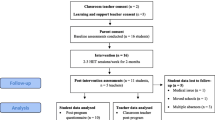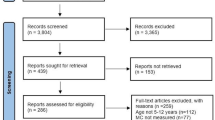Abstract
Students with Down syndrome (DS) receive school-based physical therapy (SBPT), however little data exists regarding services and outcomes. Using a prospective observational cohort study our aim was to explore SBPT activities and interventions, and students’ goal achievement of 46 students with DS, tracked by 17 physical therapists (PTs). PTs provided on average 24.0 min/week direct service and 11.6 min/week services on behalf of the student. The most frequent activities employed were physical education/recreation, mobility, and sitting/standing/transitions. The most frequent interventions implemented were neuromuscular, mobility, and musculoskeletal. Although students individually met 69.5% of their primary outcome goals, their achievement could not be explained by total minutes of either direct and minutes on behalf of SBPT, nor minutes spent in most frequent activity.
Similar content being viewed by others
References
Barnhart, R. C., & Connolly, B. (2007). Aging and Down syndrome: Implications for physical therapy. Physical Therapy, 87(10), 1399–1406.
Blundell, S. W., Shepherd, R. B., Dean, C. M., Adams, R. D., & Cahill, B. M. (2003). Functional strength training in cerebral palsy: A pilot study of a group circuit training class for children aged 4–8 years. Clinical Rehabilitation, 17(1), 48–57.
Bodkin, A. W., Robinson, C., & Perales, F. P. (2003). Reliability and validity of the gross motor function classification system for cerebral palsy. Pediatric Physical Therapy, 15(4), 247–252.
Chiarello, L. A., Effgen, S. K., Jeffries, L., McCoy, S. W., & Bush, H. M. (2016). Student outcomes of school-based physical therapy as measured by Goal Attainment Scaling. Pediatric Physical Therapy, 28(3), 277–284.
Coster, W., Deeney, T. A., Haley, S., & Haltiwanger, J. (1998). School function assessment. New York: Psychological Corporation.
Davies, P. L., Soon, P. L., Young, M., & Clausen-Yamaki, A. (2004). Validity and reliability of the school function assessment in elementary school students with disabilities. Physical & Occupational Therapy in Pediatrics, 24(3), 23–43.
Effgen, S. K., Chiarello, L., & Milbourne, S. A. (2007). Updated competencies for physical therapists working in schools. Pediatric Physical Therapy, 19(4), 266–274.
Effgen, S. K., & Kaminker, M. K. (2014). Nationwide survey of school-based physical therapy practice. Pediatric Physical Therapy, 26(4), 394–403.
Effgen, S. K., & Kaminker, M. K. (2017). The educational environment. In R. J. Palisano, M. N. Orlin, & J. Schreiber (Eds.), Campbell’s physical therapy for children (5th ed., pp. 723–750). St. Louis, MO: Saunders Elsevier.
Effgen, S. K., McCoy, S. W., Chiarello, L. A., Jeffries, L. M., & Bush, H. M. (2016). Physical therapy-related child outcomes in school: An example of practice-based evidence methodology. Pediatric Physical Therapy, 28(1), 47–56.
Effgen, S. K., & McEwen, I. R. (2008). Review of selected physical therapy interventions for school age children with disabilities. Physical Therapy Reviews, 13(5), 297–312.
Esposito, P. E., MacDonald, M., Hornyak, J. E., & Ulrich, D. A. (2012). Physical activity patterns of youth with Down syndrome. Intellectual and Developmental Disabilities, 50(2), 109–119.
Galli, M., Rigoldi, C., Brunner, R., Virji-Babul, N., & Giorgio, A. (2008). Joint stiffness and gait pattern evaluation in children with Down syndrome. Gait & Posture, 28(3), 502–506.
Harris, P. A., Taylor, R., Thielke, R., Payne, J., Gonzalez, N., & Conde, J. G. (2009). Research electronic data capture (REDCap)—A metadata-driven methodology and workflow process for providing translational research informatics support. Journal of Biomedical Information, 42(2), 377–381.
Horn, S. D., DeJong, G., & Deutscher, D. (2012). Practice-based evidence research in rehabilitation: An alternative to randomized controlled trials and traditional observational studies. Archives of Physical Medicine and Rehabilitation, 93(8), S127–S137.
Horn, S. D., DeJong, G., Ryser, D. K., Veazie, P. J., & Teraoka, J. (2005). Another look at observational studies in rehabilitation research: Going beyond the holy grail of the randomized controlled trial. Archives of Physical Medicine and Rehabilitation, 86(12), 8–15.
Horn, S. D., & Gassaway, J. (2010). Practice based evidence: Incorporating clinical heterogeneity and patient-reported outcomes for comparative effectiveness research. Medical Care, 48(6), S17–S22.
IDEA. (2004). Public Law 108-446, Individuals with Disabilities Education Improvement Act of 2004. http://www.copyright.gov/legislation/pl108-446.pdf.
Jeffries, L. M., McCoy, S. W., Effgen, S. K., Chiarello, L. A., & Villasante-Tezanos, A. (2018). Description of the services, activities and interventions within school-based physical therapy practice across the United States. Physical Therapy, 99(1), 98–108.
Kaminker, M. K., Chiarello, L. A., O’Neil, M. E., & Dichter, C. G. (2004). Decision making for physical therapy service delivery in schools: A nationwide survey of pediatric physical therapists. Physical Therapy, 84(10), 919–933.
King, G. A., McDougall, J., Palisano, R. J., Gritzan, J., & Tucker, M. A. (2000). Goal Attainment Scaling: Its use in evaluating pediatric therapy programs. Physical & Occupational Therapy in Pediatrics, 19(2), 31–52.
Kiresuk, T. J., Smith, A., & Cardillo, J. E. (2014). Goal Attainment Scaling: Applications, theory, and measurement. New York: Psychology Press.
Ko, J., Woo, J. H., & Her, J. G. (2011). The reliability and concurrent validity of the GMFCS for children with cerebral palsy. Journal of Physical Therapy Science, 23(2), 255–258.
LaForme-Fiss, A. C., Effgen, S. K., Page, J., & Shasby, S. (2009). Effect of sensorimotor groups on gross motor acquisition for young children with Down syndrome. Pediatric Physical Therapy, 21(2), 158–166.
Malak, R., Kotwicka, M., Krawczyk-Wasielewska, A., Mojs, E., & Szamborski, W. (2013). Motor skills, cognitive development and balance functions of children with Down syndrome. Annals of Agricultural and Environmental Medicine, 20(4), 803–806.
McConlogue, A., & Quinn, L. (2009). Analysis of physical therapy goals in a school-based setting: A pilot study. Physical & Occupational Therapy in Pediatrics, 29(2), 154–169.
McCoy, S.W., Jeffries, L. M., Effgen, S., Chiarello, L., Gregory, W., Smarr, J., & Stoner, T. (2014). School Physical Therapy Interventions for Pediatrics (S-PTIP) Manual and Forms. Accessed December 4, 2014, from http://www.mc.uky.edu/healthsciences/grants/ptcounts/.
McCoy, S. W., & Linn, M. (2011). Validity of the school-physical therapy interventions for pediatrics data system for use in clinical improvement design studies. Pediatric Physical Therapy, 23, 121–122.
Peters, J. M., & Wright, A. M. (1999). Development and evaluation of a group physical activity programme for children with developmental co-ordination disorder: An interdisciplinary approach. Physiotherapy Theory and Practice, 15(4), 203–216.
Rosenbaum, P. L., Palisano, R. J., Bartlett, D. J., Galuppi, B. E., & Russell, D. J. (2008). Development of the gross motor function classification system for cerebral palsy. Developmental Medicine and Child Neurology, 50(4), 249–253.
Steenbeek, D., Gorter, J. W., Ketelaar, M., Galama, K., & Lindeman, E. (2011). Responsiveness of Goal Attainment Scaling in comparison to two standardized measures in outcome evaluation of children with cerebral palsy. Clinical Rehabilitation, 25(12), 1128–1139.
Steenbeek, D., Ketelaar, M., Galama, K., & Gorter, J. W. (2007). Goal Attainment Scaling in paediatric rehabilitation: A critical review of the literature. Developmental Medicine and Child Neurology, 49(7), 550–556.
Steenbeek, D., Ketelaar, M., Lindeman, E., Galama, K., & Gorter, J. W. (2010). Interrater reliability of Goal Attainment Scaling in rehabilitation of children with cerebral palsy. Archives of Physical Medicine and Rehabilitation, 91(3), 429–435.
Stuberg, W., & DeJong, S. L. (2007). Program evaluation of physical therapy as an early intervention and related service in special education. Pediatric Physical Therapy, 19(2), 121–127.
Thomason, H. K., & Wilmarth, M. A. (2015). Provision of school-based physical therapy services: A survey of current practice patterns. Pediatric Physical Therapy, 27(2), 161–169.
Wang, W. Y., & Ju, Y. H. (2002). Promoting balance and jum** skills in children with Down syndrome. Perceptual and Motor Skills, 94(2), 443–448.
Winders, P. C. (2001). The goal and opportunity of physical therapy for children with down syndrome. Retrieved from http://ds-health.com/physther.htm.
Acknowledgments
This article is a product of the PT COUNTS study which was supported by the Institutes of Education Sciences, US Department of Education, Grant R324A110204.
Funding
This study was supported by the Institutes of Education Sciences, US Department of Education, Grant Number R324A110204.
Author information
Authors and Affiliations
Contributions
GEN participated in develo** the idea for the research article, conducted data analysis, writing the article from doctoral thesis for DSc degree, revision of edits, and proofing the final manuscript. SKE participated in develo** the idea for the research article, conducted data collection for the PT COUNTS study, writing, providing additional edits during revision, and proofing subsequent submissions. SA participated in writing, providing additional edits during revision, and proofing subsequent submissions. JB participated in data analysis, and provided additional edits during revision. LMJ participated in develo** the idea for the research article, conducted data collection in the PT COUNTS study, participated in data analysis, writing, providing additional edits during revision process, and proofing the final manuscript.
Corresponding author
Ethics declarations
Conflict of interest
Glen E. Neal, MPT, DSc, PCS declares that he has no conflict of interest. Susan K. Effgen, PT, PhD, FAPTA declares that she has not conflict of interest. Lynn M. Jeffries, PT, DPT, PhD, PCS declares that she has not conflict of interest. Sandra Arnold, PT, PhD declares that she has no conflict of interest. Jonathan Baldwin, MS, CNMT, RT(CT) declares that he has no conflict of interest.
Ethical Approval
All procedures performed in studies involving human participants were in accordance with ethical standards of the institutional and/or national research committee and with the 1964 Helsinki declaration and its later amendments or comparable ethical standards.
Informed Consent
Informed consent was obtained from all individual participants included in the study.
Additional information
Publisher's Note
Springer Nature remains neutral with regard to jurisdictional claims in published maps and institutional affiliations.
Rights and permissions
About this article
Cite this article
Neal, G.E., Effgen, S.K., Arnold, S. et al. Description of School-Based Physical Therapy Services and Outcomes for Students with Down Syndrome. J Autism Dev Disord 49, 4019–4029 (2019). https://doi.org/10.1007/s10803-019-04109-7
Published:
Issue Date:
DOI: https://doi.org/10.1007/s10803-019-04109-7




